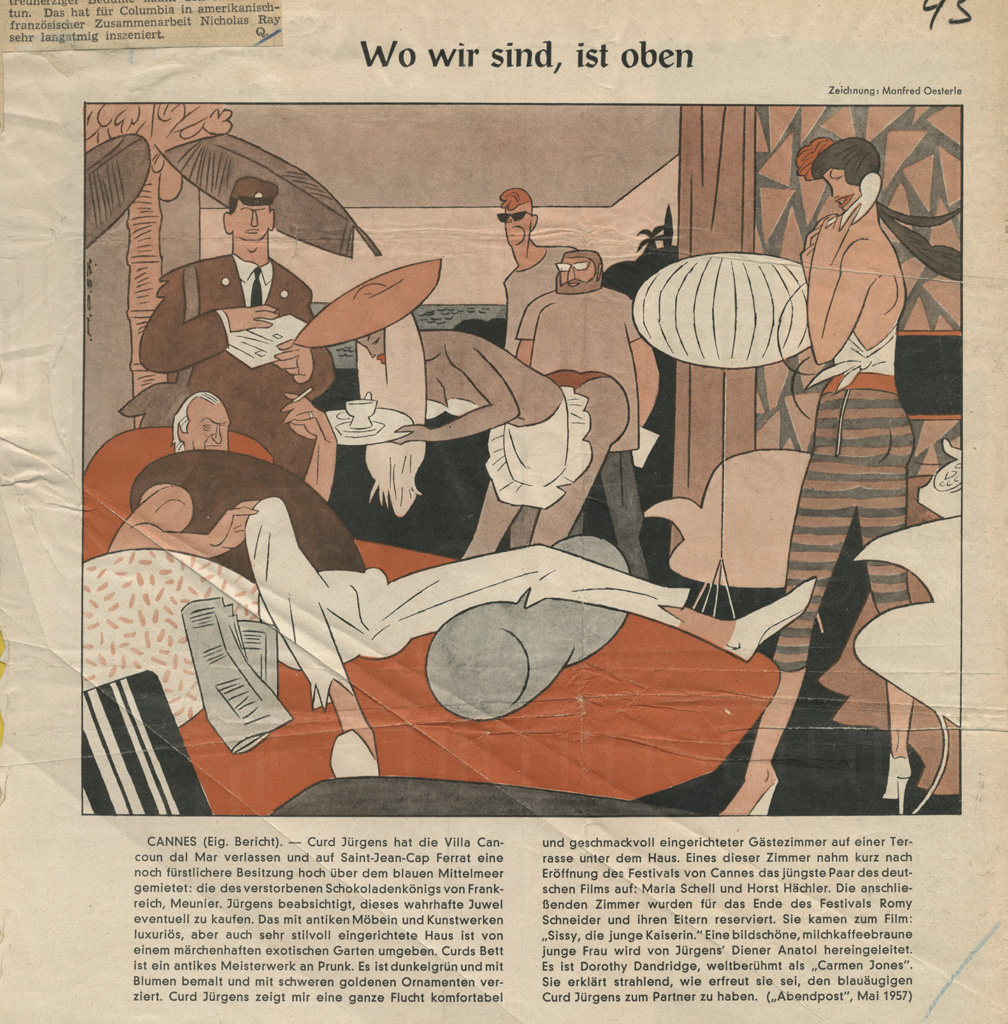CURD JÜRGENS AND THE YELLOW PRESS, PART 2
By Henning Engelke

By Henning Engelke
One more thing is essential to the star’s public image as disseminated by the tabloid press: a star does not live like normal people. Not merely does he consort with screen goddesses whose brilliance lets his own light beam more brightly, he also earns much more money than the average reader of the tabloid press – and this not only may, but indeed must, become known, even if the reports about Curd Jürgens’ wages that appeared in a variety of papers in 1957 have to be glossed over with reference to an indiscretion.[i] But making money alone is not enough – it must be laid out properly: Money in – lots of it – must be as quickly as possible money out, and be changed into something else: visible signs of social status.
In 1957 Curd Jürgens had rented and subsequently bought one of these symbols – a huge villa in Cap Farrat with a vista of the sea. This investment brought dividends in the gossip columns in newspapers in the form of headlines like “The tsar’s courier lives like a monarch”.[ii]
And if the reader is kept away by high fences and a spacious park and prevented from approaching the star in his luxurious private surroundings, he can dispatch a surrogate, gossip columnist: “Let’s have a look inside!” The first thing the reporter mentions is the – for the 1950s – astronomical sum of 10,000 DM a month rent. He then moves on to the large number of servants, the splendour of the rooms, the fantastic view and the celebrity neighbours: Prince Rainier and his wife Grace Patricia. A feature of this part of the public image is the additional accounts of the actor’s numerous cars and of the parties he hosts – in which the “Norman wardrobe” is able to give proof of his capacity for alcohol, in the context of the time an attribute of vigorous masculinity.
As Aeneas must arrive in Latium in order to achieve his true destiny, so a film star must make a film in Hollywood in order to be able establish real fame. In tune with his role pattern and playing a U-Boat commander, Curd Jürgens seems to achieve this with THE ENEMY BELOW (1957, D: Dick Powell). His adversary in the film is played by Robert Mitchum. At least in the German popular press he is now celebrated as a “top world star” or – as the journalist Hannes (Hunter) Obermaier formulates it – a “world star”. Over the week, Curd hardly had any free time, standing in front of the camera till late at night. On Sundays he dropped in on his nearest neighbours: Lana Turner, Alan Ladd, Judy Garland and the jazz composer Hoagy Carmichael. Bing Crosby and Gary Cooper were his preferred poker partners.”[iii]

“Abendpost: “Wo wir sind, ist oben”, May 1957
Curd Jürgens’ media figure, as established by the early 1950s, combines features of his typical roles in film and behavioural patterns that were selected from his private sphere, and concentrated them into simple images: the heart-breaker, the blond hero, the rich dandy and socialite, the “Norman wardrobe”, the world star. There was also public knowledge concerning the behavioural type of the star in general along with patterns borrowed consciously or unconsciously from other celebrities: for example, there are a number of photographs of Jürgens in poses reminiscent of a Picasso or a Hemingway.
Translation: Elizabeth Ward
Notes:
[i] Jürgens confesses later that in some cases he had told the press higher salaries than he actually got, Austrian newspaper Kurier, 3.6.1972.
[ii] Barely changed published amongst others in Neustädter Tageblatt, 7.6.1957, no page, and Nordwest-Zeitung, 22.6.1957.
[iii] Bild-Zeitung, no date (1957).